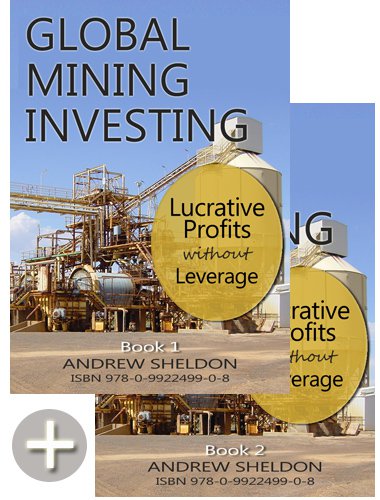
-----------------------------------------
Andrew Sheldon www.sheldonthinks.com
 Global Mining Investing $69.95, 2 Volume e-Book Set. Buy here.
Global Mining Investing $69.95, 2 Volume e-Book Set. Buy here.Global Mining Investing is a reference eBook to teach investors how to think and act as investors with a underlying theme of managing risk. The book touches on a huge amount of content which heavily relies on knowledge that can only be obtained through experience...The text was engaging, as I knew the valuable outcome was to be a better thinker and investor.
While some books (such as Coulson’s An Insider’s Guide to the Mining Sector) focus on one particular commodity this book (Global Mining Investing) attempts (and does well) to cover all types of mining and commodities.
Global Mining Investing - see store


 then it rose 900 pts to close 299 points higher. Wow
then it rose 900 pts to close 299 points higher. Wow


 The Dow Jones Index (DJIA) fell 306pts overnight to 12,159. I see the market falling further, and I dare say it will find support at the 12,000 psychological support, even though it will be temporarily broken in day trading. In the medium term I think the market will fall to 11,650 pts before we see stability. So events are unfolding as expected.
The Dow Jones Index (DJIA) fell 306pts overnight to 12,159. I see the market falling further, and I dare say it will find support at the 12,000 psychological support, even though it will be temporarily broken in day trading. In the medium term I think the market will fall to 11,650 pts before we see stability. So events are unfolding as expected.
Japan Foreclosed Property 2015-2016 - Buy this 5th edition report!

'Buying Philippines Property – Download a free sample chapter!

'Buying NZ Property – Download the free sample readings!
The NZ property market is shaping up as one of the most attractive property investment markets for the next few years. High yielding property and the collapse of the NZD make NZ the perfect counter-cyclical investment if you buy right! In addition, there is no capital gains tax, transfer taxes, VAT/GST or wealth taxes in NZ, so rest assured that NZ property is tax-effective! Learn more now!



Japan Foreclosed Property 2015-2016 - Buy this 5th edition report!
